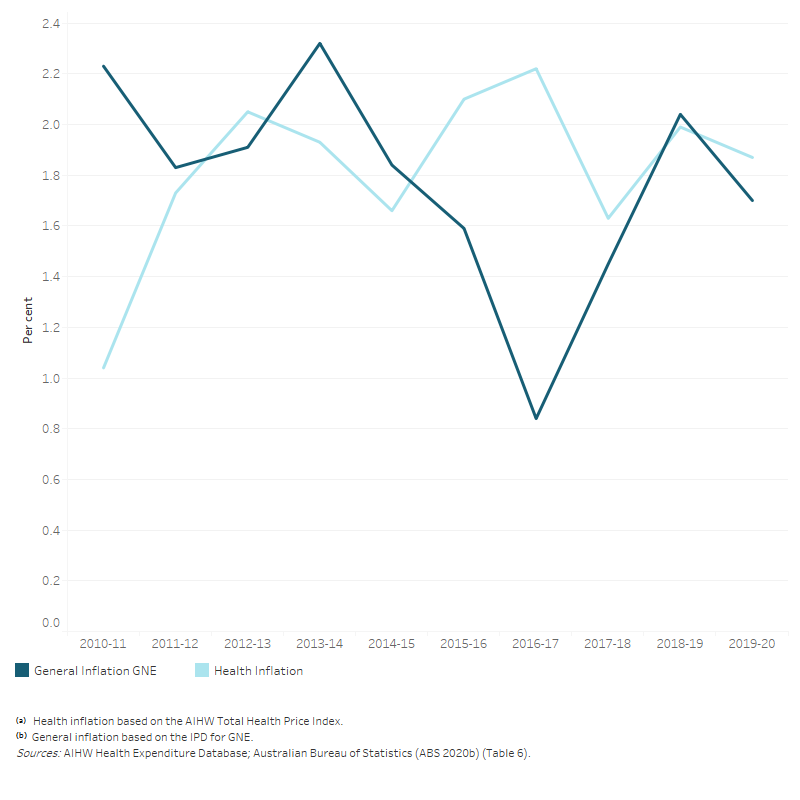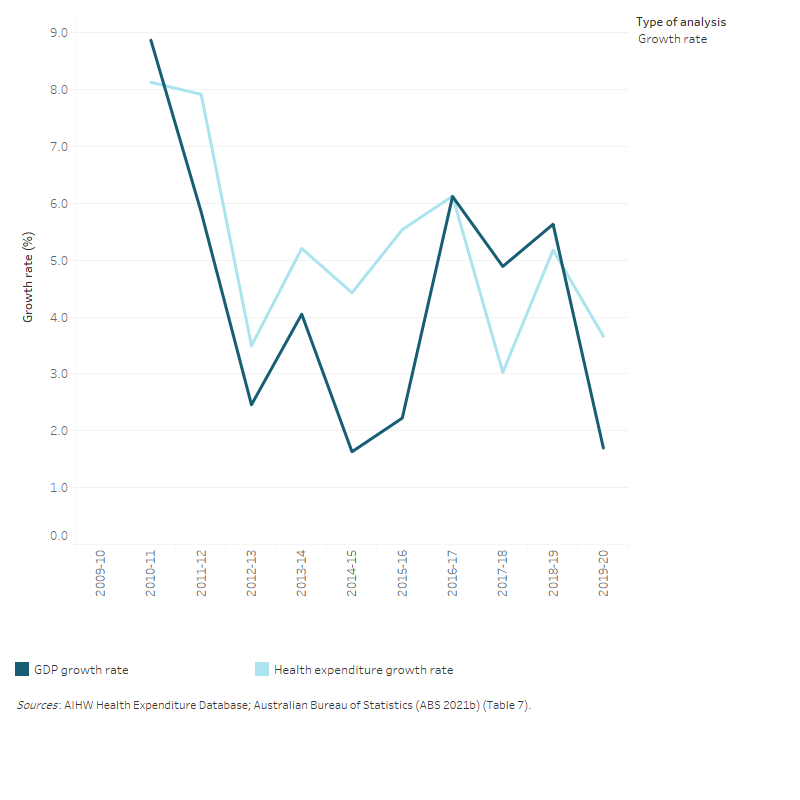The health sector relative to the economy
Health prices
From 2018–19 to 2019–20, health inflation was 1.87%. General inflation, using the implicit price deflator (IPD) for gross national expenditure (GNE), was 1.70%. As such, excess health inflation was 0.16%, indicating that prices of health goods and services were rising slightly faster than prices in the general economy (Figure 5).
Over the decade to 2019–20, prices in the health sector were relatively stable compared with prices in the broader economy. This resulted in varying levels of excess health inflation, ranging from –1.17% in 2010–11 to 1.38% in 2016–17.
Figure 5: Annual health inflation⁽ᵃ⁾ and general inflation⁽ᵇ⁾ rates, 2009–10 to 2019–20
The line graph shows that annual health inflation rates were more stable than annual general inflation rates from 2009–10 to 2019–20. Annual health inflation rates ranged from 1.03 and 2.22 per cent while annual general inflation rates using the GNE IPD varied from 0.84 per cent and 2.32 per cent during this period. Annual health inflation decreased overall from 1.99 per cent in 2018–19 to 1.87 per cent in 2019–20. Meanwhile, annual general inflation rate using the GNE IPD decreased overall from 2.04 per cent to 1.70 per cent over the same period.

Inflation and deflators
Inflation refers to changes in prices over time. It can be positive (prices are rising over time and the same volume of goods cost more, so money is losing value) or negative (the same volume of goods are costing less).
Inflation is measured using price indexes, also known as deflators. These show the amount a price has changed over time relative to a base year. The reference year, or base year, for the deflators used in this report is 2019–20.
Health inflation
Health inflation is a measure of the average rate of change in prices within the health goods and services sector of the economy.
See Australian National Health Account: concepts, methodology and data sources for more information on health deflators and industry-wide deflators.
General inflation
General inflation refers to the average rate of change in prices throughout the economy over time. There are different ways to measure the economy, and many methods for deriving deflators. The specific deflator can affect whether prices in the health sector appear to have risen slower or faster than the general inflation rate (excess health inflation).
In this report, the measure used for this is the IPD for GNE. GNE is a measure of the value of final expenditures on the goods and services purchased in the economy, including imports but excluding exports. IPD is an indicator of changes in the purchase price of these goods.
Excess health inflation
Excess health inflation is the amount by which the rate of health inflation exceeds general inflation. Excess health inflation will be positive when health prices are rising more rapidly than prices generally throughout the economy. It will be negative when the general level of prices throughout the broader economy are rising more rapidly than health prices.
Health spending and gross domestic product
The ratio of health spending to GDP, showing the proportion of total economic activity represented by the health sector, is an indicator of the contribution of health spending to the overall economy.
In 2019–20, health spending accounted for 10.2% of GDP in Australia, 0.2 percentage points higher than in 2018–19. This is largely attributed to slower growth in nominal GDP coinciding with the early stages of the COVID-19 pandemic (Figure 6).
Figure 6: Ratio of total health expenditure to GDP, and annual growth rate, current prices, 2009–10 to 2019–20
The line graph shows that annual growth rates in Gross Domestic Product is more volatile compared to the annual growth rates in total health spending from 2009–10 to 2019–20. Annual growth rates in total health spending ranged from 3.0 per cent to 8.1 per cent. Meanwhile, annual growth rates in Gross Domestic Product ranged from 1.7 per cent to 8.9 per cent and with an average of 4.3 per cent. In this 10-year period, the ratio of health spending to Gross Domestic Product was relatively consistent and increased overall from 9.3 per cent in 2009–10 to 10.2 per cent in 2019–20.



